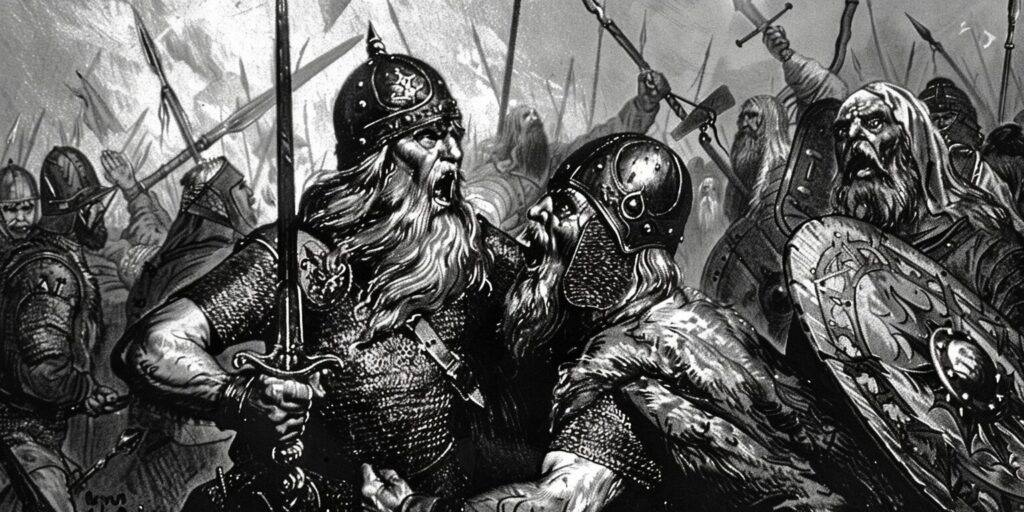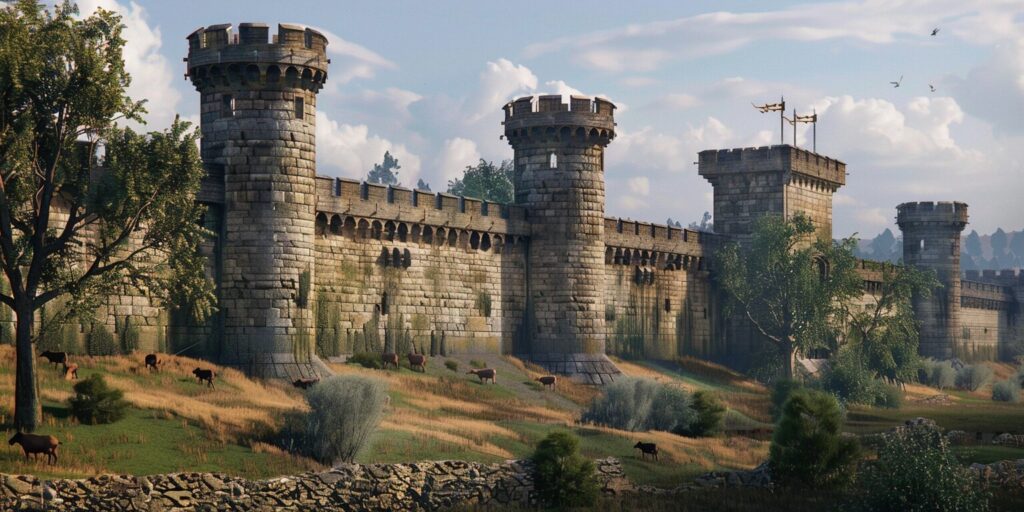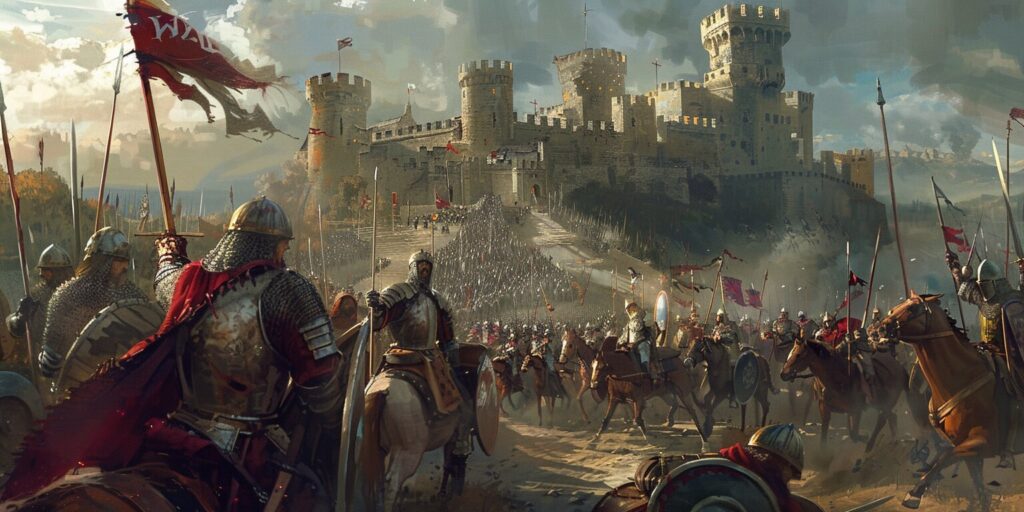Viking Raids and Warfare, Vikings
The Siege of Esesfelth 817: Prelude to the Viking Age and Denmark’s Rise
Welcome to the captivating world of medieval warfare, where history comes alive with the Siege of Esesfelth in 817. This pivotal event paved the way for the Viking Age and significantly influenced Denmark’s rise as a major medieval European power. Led by Danish Vikings, this siege marked a turning point in the history of the region.
The Siege of Esesfelth, which took place in 817, offers us a fascinating glimpse into the complex web of Frankish-Danish relations during this period. It sheds light on diplomatic ties, trade relationships, and political alliances between the Franks and the Danes. Furthermore, this siege showcases the impact of Viking raids and how they influenced these intricate relations.
Join us as we explore the Siege of Esesfelth in detail – from its impact on the Frankish fortress and the local Frankish ruler to the factors that led to the conflict between the Danes, the Obodrites, and the Franks. Discover the insights gained from the excavation of Esesfelth, uncovering the secrets of Carolingian fortification techniques and the presence of Scandinavians in the region, shedding light on the Saxon and Danish struggle over Nordalbingia.
What Was The Significance Of Esesfelth In 817?
Esesfelth, a Frankish fortress, held great importance in 817 due to its strategic location and its role in the complex web of Frankish-Danish relations. The fortress symbolized power and control in the region and played a central role in medieval conflicts and alliances, particularly reflected in the siege’s fight for Nordalbingia between the Frankish, Saxon, and Danish forces.
The Siege of Esesfelth, a pivotal moment in the fight for Nordalbingia, provides us with valuable insights into the intricate relationship between the Franks and the Danes. It sheds light on the diplomatic ties, trade relationships, and political alliances that existed between the two powers during this period. The siege also highlights the impact of Viking raids and their role in shaping these relations, particularly through the fight for Nordalbingia.
Insight Into Frankish-Danish Relations
The Siege of Esesfelth reveals the multifaceted nature of Frankish-Danish relations. It showcases the diplomatic ties and trade relationships that existed between the Franks and the Danes, emphasizing the significance of Esesfelth as a point of interaction and negotiation between the two powers. The siege also portrays the dynamic nature of these relations, influenced by political alliances and the ever-present threat of Viking raids, offering insights into the strategic value of the Frankish fortress of Esesfelth in the fight for Nordalbingia.

Reconstruction And Simulation Of The Fortress
To understand the significance of Esesfelth, it is crucial to reconstruct and simulate the fortress. This allows us to gain insights into its architectural design, construction techniques, and defensive capabilities. By analyzing the fortification strategies employed by the Franks at Esesfelth, we can better understand the military tactics of the time and how they influenced the outcome of the siege.
How Did The Viking Siege Affect The Frankish Fortress?
The Viking siege on Esesfelth profoundly impacted the Frankish fortress and its inhabitants. The failed attack by the Danish Vikings exposed weaknesses in the fortress’s defenses and highlighted the need for improved defensive strategies. Furthermore, the siege had significant consequences for the local Frankish ruler and his control over the region.
Failed Attack By Danish Vikings
The Danish Vikings launched an unsuccessful attack on Esesfelth, which revealed their tactical failures and inability to breach the fortress’s defenses. This failed siege sheds light on the military tactics employed by the Vikings and the effectiveness of the Frankish defensive strategies. It also showcases the resilience and strength of the Frankish forces defending the fortress.
Impact On The Local Frankish Ruler
The Viking siege significantly impacted the local Frankish ruler and his control over the region. It highlighted the challenges Charlemagne faced in maintaining power and defending his territories against external threats, especially from the Danes and Obodrites in the context of the struggle for Nordalbingia. The siege also had political implications, triggering shifts in the region’s power dynamics between the Franks and the Danes, particularly emphasizing the strategic fight for Nordalbingia.
What Led To The Conflict Between The Danes, Obodrites, And The Franks?
The conflict between the Danes, Obodrites, and Franks can be attributed to a variety of factors, including complex political relations, regional rivalries, and territorial disputes. These factors significantly shaped the tensions that ultimately led to the siege of Esesfelth in 817.
Frankish-Danish Relations In Nordalbingia
Nordalbingia, a region in northern Germany, was the backdrop for intense power struggles, political alliances, and military conflicts between the Franks and Danes during the early 9th century. The territory’s strategic location along trade routes made it a key player in the events leading up to the conflict.
Frankish-Danish relations in Nordalbingia were complex and often volatile. The two powers engaged in rivalries and territorial disputes, vying for regional control and influence. Political alliances were formed and broken during this period, further fueling tensions between the Franks and the Danes, especially in the context of Charlemagne’s campaigns.
Role Of Nordalbingia During The Early 9th Century
Nordalbingia held a prominent position in the political and economic landscape of the early 9th century. Its location along crucial trade routes allowed it to serve as a regional power, attracting merchants and facilitating cultural exchange.
The clash of powers in Nordalbingia had significant implications for the surrounding regions. The conflicts and power struggles in this territory influenced the events that culminated in the siege of Esesfelth in 817, marking a significant episode in Charlemagne’s campaigns.
Understanding the intricacies of Frankish-Danish relations and the role of Nordalbingia provides valuable context for comprehending the origins of the conflict and the subsequent siege. By examining the regional dynamics and the factors contributing to the tensions, including the strategic importance of the Frankish fortress of Esesfelth, we gain a deeper understanding of the complex interactions that shaped medieval Europe.
What Insights Can We Gain From The Excavation Of Esesfelth?
The excavation of Esesfelth has provided us with valuable information about various aspects of medieval history. Archaeological discoveries have helped us gain a deeper understanding of Carolingian fortification techniques and military strategies employed during the siege. Additionally, the excavation has shed light on the Scandinavian presence in the region and its impact on the events surrounding the siege.
Carolingian Fortification Techniques
The excavation of Esesfelth has given us a rare opportunity to study the fortification techniques utilized by the Carolingian empire during the siege. By examining the remains of defensive structures and analyzing the layout of the fortress, we have gained insights into the military advancements of the time. This knowledge enhances our understanding of medieval warfare and the role of fortifications, like the ramparts of the Frankish fortress of Esesfelth, in protecting territories.

Scandinavian Presence In The Region
The excavation of Esesfelth has also unearthed evidence of the Scandinavian presence in the region during the Viking Age. By discovering artifacts and examining trade networks, we have learned about the Norse influence and cultural interactions that shaped the events surrounding the siege. This allows us to gain a deeper understanding of the historical connections between the Scandinavians and the Franks and their impact on the region’s trade networks and cultural exchanges.
Conclusion
The Siege of Esesfelth in 817 is of tremendous historical significance, as it foreshadowed the Viking Age and marked a significant turning point in medieval European history. This event offers valuable insights into the complex interactions, power struggles, and military strategies that shaped the medieval world, including conflicts over the Frankish fortress of Esesfelth.
Understanding the significance of Esesfelth and the Viking siege provides a comprehensive view of this pivotal event. It reminds us of the conflicts and alliances that defined the medieval era and showcases the intricate relations between the Franks, Danes, and other regional powers.
Additionally, the excavation of Esesfelth and its archaeological discoveries offer valuable information about Carolingian fortification techniques and the presence of Scandinavians in the region. These insights shed light on the military advancements of the time and the cultural exchanges that influenced the events surrounding the siege.
Overall, the Siege of Esesfelth in 817 holds immense historical significance. By delving into its impact, the factors leading to the conflict, and the insights gained from excavation, we understand the Viking Age, medieval conflicts, and the complex dynamics that shaped Europe during this critical period.

